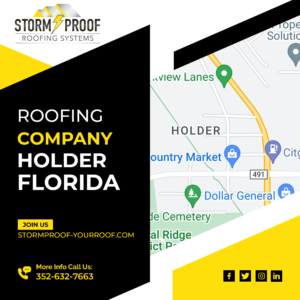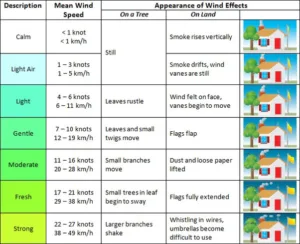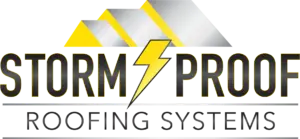Resilient Roofs: Navigating Storm Damage in Inverness, FL with Expert Repair Solutions
Introduction to Inverness, FL and its Stormy Weather
Welcome to Inverness, FL, a hidden gem nestled in the heart of Citrus County. This charming small town is known for its picturesque landscapes, friendly locals, and an undeniable allure that draws visitors from far and wide.
But behind this idyllic facade lies a reality that residents have come to accept: stormy weather. Yes, dear reader, Inverness is no stranger to the wrath of Mother Nature’s tempestuous tantrums.
An Overview of Inverness, FL as a Charming Small Town in Citrus County
Picture this: quaint streets lined with historic buildings painted in pastel hues that evoke a sense of nostalgia. Canopied by majestic oak trees draped with Spanish moss, the town exudes a timeless charm that instantly captivates anyone who sets foot in it. The welcoming atmosphere resonates through every nook and cranny of this tight-knit community.
Don’t be fooled by its small size; Inverness has amenities and attractions aplenty. From local boutiques selling unique handmade crafts to cozy cafes serving up delectable treats – you’ll find yourself immersed in a world where time slows down and life’s simple pleasures take center stage.
Highlighting the Region’s Susceptibility to Severe Storms and Hurricanes
But amidst the tranquility lies an unavoidable truth – Inverness is no stranger to nature’s fury. Located along Florida’s Gulf Coast, this town finds itself squarely within the notorious “Hurricane Alley.” As summer rolls around each year, residents hold their breath as dark clouds gather on the horizon.
The region’s geographical location leaves it vulnerable to severe storms and hurricanes that sweep through with relentless force. These formidable tempests can unleash a torrent of chaos, wreaking havoc on everything in their path.
From powerful winds that rip trees out of the ground to torrential rains that flood streets and homes, Inverness has seen it all. It takes a resilient spirit to call this place home.
Inverness residents have learned to be prepared, to batten down the hatches and ride out the storms, both literal and metaphorical. They know that safety comes first, and with each passing storm, they emerge stronger together.
Understanding the Impact of Storm Damage on Roofs
The Wrath of Storms in Inverness
Oh, the weather in Inverness, Florida can be quite a tempestuous affair! Nestled in Citrus County, this charming small town is no stranger to severe storms and the occasional hurricane.
When nature unleashes her fury upon Inverness, it’s the roofs that often bear the brunt of her wrath. The combination of high winds, heavy rain, and flying debris can cause considerable damage to rooftops throughout the area.
Roof-Ruining Culprits: Unveiling Common Types of Damage
When storms hit Inverness with all their might, they leave no shingle unturned. Understanding the various types of damage that can be inflicted upon roofs is essential for homeowners and repair experts alike. One common outcome is missing or damaged shingles.
These small yet crucial components are easily dislodged by strong gusts or projectiles propelled by fierce winds. Another pesky problem comes in the form of leaks caused by compromised flashing or punctured roof surfaces.
Flashing refers to those thin metal strips installed around chimneys, vents, and skylights to prevent water from seeping into your home. However, during wild weather events in Inverness, these protective strips can become loose or even torn away entirely.
Gutters also take a beating during storms as they try valiantly to channel torrents of rainwater away from your home’s foundation. Heavy rainfall combined with fallen leaves and debris often result in clogged gutters and downspouts that are unable to perform their duty effectively.
It is worth noting that other forms of damage such as sagging roofs due to excessive water accumulation or weakened structures caused by fallen trees are not uncommon either but require immediate professional attention to ensure safety. When storms brew in Inverness, they pose a significant threat to the integrity of roofs.
Understanding the nature of these storms and their potential impact is crucial for homeowners in order to take proactive measures and swiftly address any damage that may occur. So, let’s buckle up and dive into the essential steps for repairing storm-damaged roofs in this quaint town!
Assessing the Damage: Steps to Identify Roof Issues
Conducting a Visual Inspection of the Roof for Obvious Signs of Damage
When it comes to assessing storm damage on your roof, the first thing you need to do is grab a sturdy ladder and bring out your inner Sherlock Holmes. Armed with a notepad and a keen eye for detail, climb up to get an eagle-eye view of your rooftop kingdom. Look out for any missing or damaged shingles, as they are often easy to spot.
These naughty culprits can be blown away by strong winds or pummeled by hailstones like helpless victims. As you step onto the roof surface, beware of slipping hazards and always wear appropriate footwear that provides good traction.
Take your time and inspect each section carefully, as sometimes damage might be hidden in plain sight. Look for cracks, tears, or curling edges in shingles – these are telltale signs that something is awry above your head.
Don’t forget to check around chimneys, vents, and other roof penetrations as well. These areas are notorious for leaks and can be vulnerable during storms.
Keep an eye out for loose flashing or any signs of separation from adjoining materials. If you spot any issues during this visual inspection phase, don’t panic just yet; we’ll delve into solutions later.
Checking for Leaks and Water Stains on Ceilings as Indicators of Roof Damage
Water stains on ceilings are like nature’s way of pointing a big arrow at the source of your roofing problems. So if you notice mysterious discolorations resembling Rorschach inkblots on your ceiling after a stormy night, it’s high time you investigate further.
Grab your trusty flashlight (or smartphone with its handy-dandy flashlight app) and head up into the attic like an intrepid explorer venturing into the unknown. Keep your eyes peeled for any signs of water intrusion, such as damp spots, discoloration, or even actual puddles.
These are red flags that your roof might have succumbed to storm damage and is letting unwanted moisture weasel its way inside. While you’re up there, don’t forget to inspect the underside of the roof deck as well.
Look for any signs of water stains or mold growth, as these can indicate prolonged leakage and potential structural damage. Remember, assessing the extent of storm damage on your roof is not a task to be rushed.
Take your time and inspect every nook and cranny with care. It’s better to be thorough now than pay the price later when a small issue becomes an expensive problem.
Safety First: Precautions Before Repairing Storm-Damaged Roofs
Emphasizing the importance of personal safety during roof inspections and repairs
When it comes to repairing storm-damaged roofs, ensuring personal safety should be your top priority. Climbing up on a roof can be risky business, especially after a storm has wreaked havoc. It’s essential to exercise caution and take necessary precautions before you even set foot on that ladder.
Firstly, never underestimate the power of a good pair of sturdy shoes with slip-resistant soles. You’ll need footwear that provides excellent traction, allowing you to maintain your balance on wet or slippery surfaces.
Avoid wearing sandals or flip-flops; they won’t provide adequate protection against potential falls. Secondly, never work alone when inspecting or repairing a storm-damaged roof.
Having someone else with you can make all the difference in case of an accident or emergency. They can lend a helping hand, fetch tools or materials as needed, and act as an extra set of eyes to ensure your own safety.
Recommending the use of proper safety equipment such as harnesses and helmets
To promote safe roof repairs after storms, it’s crucial to equip yourself with the right gear. The most essential piece of equipment is undoubtedly a secure harness system that keeps you tethered to the roof structure at all times. This prevents any accidental slips or falls from turning into devastating accidents.
Wearing a helmet might not be something we typically associate with roofing repairs, but it’s an important aspect often overlooked. A well-fitted helmet will provide protection against falling debris or unexpected bumps while working in confined spaces on your damaged roof.
To further enhance safety measures during storm-damage repairs, consider using knee pads for added comfort and protection when kneeling or crouching on the roof surface. Additionally, gloves will not only safeguard your hands from sharp edges or materials but also provide a better grip on tools and materials.
Never compromise on safety when inspecting and repairing storm-damaged roofs. The risks involved demand caution, proper gear, and the presence of a reliable partner.
Protect yourself with sturdy shoes, wear a helmet, secure yourself with a harness, and take every necessary measure to ensure that you return safely from your roofing adventure. Remember, it’s better to be safe than sorry!
DIY vs Professional Help: Making an Informed Decision
The Age-Old Dilemma: Repairing Storm-Damaged Roofs Yourself?
When faced with a storm-damaged roof, the question arises: should you try to fix it yourself or seek professional help? Let’s weigh the pros and cons of each option. Opting for a DIY approach can be enticing, especially for minor repairs or temporary fixes.
It allows you to save money and gives you a sense of accomplishment. Plus, there are various resources available online, from tutorials to step-by-step guides, making it seem like a manageable task.
Exploring DIY Options for Minor Repairs or Temporary Fixes
For minor roof repairs caused by storms in Inverness, FL, there are indeed some DIY options worth considering. Patching small holes or replacing shingles damaged by strong winds can be tackled with basic tools and materials available at local hardware stores.
You can find tutorials on assessing the damage and applying temporary fixes that can hold up until professional help is available. However, it’s important to note that even small repairs require some level of expertise.
Without the proper knowledge and experience, attempting complex repairs could worsen the situation or compromise your safety. Additionally, keep in mind that these temporary fixes are not meant to be long-term solutions but rather stopgaps until professional assistance arrives.
Highlighting Potential Risks and Limitations Associated
While DIY may seem appealing at first glance, there are potential risks and limitations to consider when repairing storm-damaged roofs yourself. Firstly, working at heights without proper safety precautions can lead to accidents and injuries – don’t underestimate the dangers involved! Secondly, even seemingly straightforward repairs might have underlying issues that only experts can detect.
Ignoring these underlying problems may result in further damage down the line. Moreover, if your insurance policy covers roof repairs, attempting repairs yourself could void any coverage you might have.
Insurance companies often require professional assessments and repairs to ensure the work is done correctly. Therefore, before embarking on a DIY project, thoroughly review your insurance policy to understand its terms and conditions.
Conclusion
Inverness, FL, with its charming small-town atmosphere and stormy weather patterns, presents homeowners with the challenge of repairing storm-damaged roofs. While some minor repairs or temporary fixes can be done independently for immediate relief, it is crucial to recognize the limitations and potential risks associated with DIY roof repair.
Knowing when professional help is necessary can save you time, money, and potentially prevent further damage. Remember that professionals possess the expertise to identify underlying issues that may not be apparent to an untrained eye.
Furthermore, their tools and techniques ensure a safer and more durable repair job. So, when it comes to major roof damage caused by storms in Inverness or any other severe circumstances, it’s best to rely on trusted professionals who can restore your home’s safety and security with confidence.



